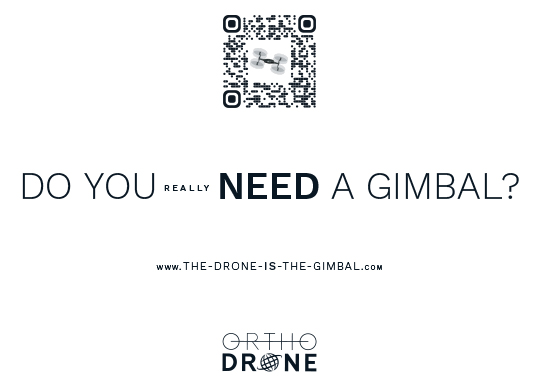IDEX 2023
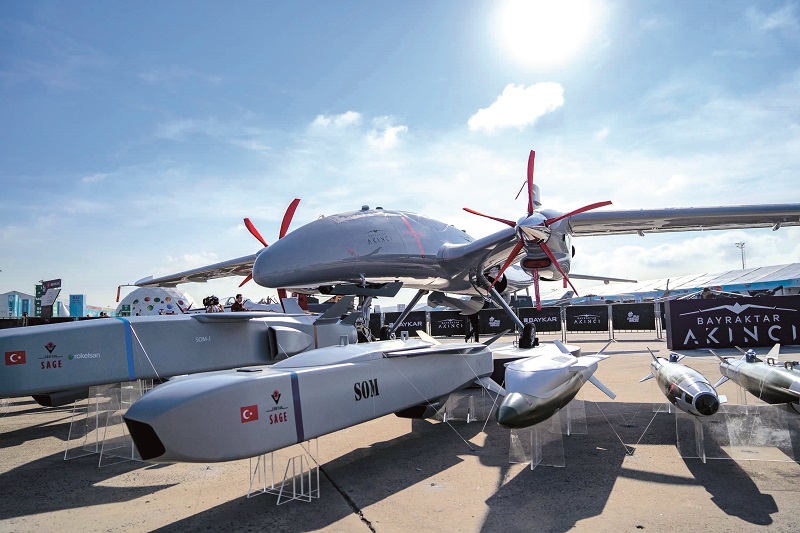
Military provision
Rory Jackson picks out some product highlights showcased at this major – and growing – event for the world’s armed forces
The International Defence Exhibition & Conference (IDEX) returned to the Abu Dhabi National Exhibition Centre in February 2023, along with its marine counterpart, the Naval Defence & Maritime Security Exhibition (NAVDEX).
The tri-service show attracted more than 1350 exhibitors – a 50% increase over the previous event, in 2021 – from 65 countries to present their latest innovations for land, air and sea forces, as well as for users across emergency services and heavy industry. A total of 23.34 billion UAE Dirhams (about £5.2 billion) worth of deals were signed over the course of the five-day event.
As ever, the region represents an enormous market for uncrewed systems, given the potential for autonomous force multipliers across defence and security. With that in mind, a number of innovative new vehicle designs and subsystems were showcased across the halls and outdoor static displays for the 130,000 attendees.
Although Bakyar Tech is perhaps most famous for the TB2 UAV and its service in the defence of Ukraine, it drew particular attention in IDEX’s outdoor static display area for the sheer size of its Akinci UAV, a 20 m-wingspan aircraft measuring 4.1 m tall and 12.2 m from nose to tail.
The Akinci has been designed as a strategic platform for defence agencies seeking long-endurance flights while carrying multiple types of payload. To enable that, the vehicle has a MTOW of 6 t and power comes from two wing-mounted turboprop engines (each producing 750 or 450 bhp, depending on the configuration).
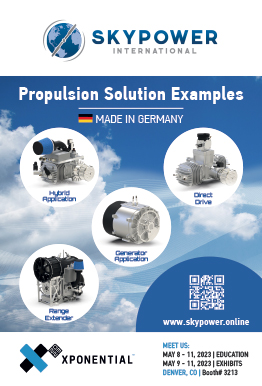
This power and architecture gives the Akinci a 24-hour maximum flight endurance, a top airspeed of 195 knots and a 1500 kg payload capacity, with integration space in the nose, hardpoints under the wings, a single cruise missile hardpoint on the central underbelly, and a multi-sensor gimbal in the undercarriage behind the centre of the fuselage.
The forward integration space ideally carries a radar, be it an air-to-air, collision avoidance, active electronically scanning array or synthetic aperture system. The wings meanwhile are designed to be capable of carrying and deploying a range of missiles and smart munitions. Lastly, the gimbal can carry a combination of EO and IR cameras with laser rangefinders and pointers.
The Akinci can fly at up to 40,000 ft (12,192 m), and for added safety and security over its flight duration it has a triple-redundant autopilot as well as redundant servo actuators, redundant lithium batteries, and dual-redundant LOS and satcom data links. The autopilot also enables fully automatic take-off, landing, taxiing and parking on standard runways, as well as a proprietary GNSS-free navigation capability by fusing data from other onboard sensors.
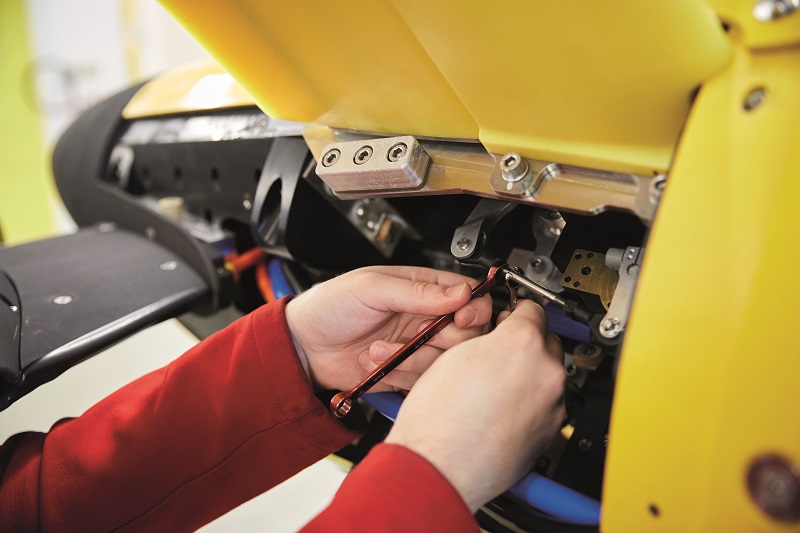
We met with Volz Servos, who promoted some of its latest project collaborations with defence organisations and governments. Of particular interest was the use of one of its extreme depth-rated actuators in a UUV operated by the National Oceanographic Centre (NOC) in Southampton, UK.
Matthew Kingsland at the NOC said, “Our Autosub Long Range AUV carried out multiple surveys underneath ice shelfs near the Thwaites Glacier in the Antarctic, which has added to our knowledge of how shelfs in the area are melting.
“We have two Volz actuators operating our control surfaces at the back – one controlling what we call our dive plane, meaning vertical, pitch-type movements, and another controlling our left-and-right fin movements. We’ve integrated Volz’s servos across all our AUVs. For instance, our Autosub 5 uses four Volz actuators in a cross-form set of control fins and it has operated at depths of 4840 m, on the Porcupine Abyssal Plain, with the servos working just fine for the duration.”
The NOC reported having previously used electromechanical linear servos made in-house, but found them prone to lock-ups, corrosion and general reliability problems. After some research into replacements, it went with the Volz DA 26-SUB, an oil-filled electromechanical rotary actuator rated to 28 V. It can deliver up to 5 Nm of peak torque, operate in temperatures from +70 to -30 oC, and has an aluminium housing rated to last for at least 1000 hours of saltwater exposure.
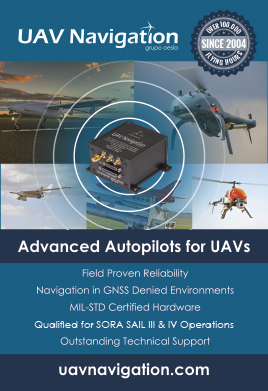
In addition to its housing compensating against ocean depth pressures that could otherwise crush the servo’s internal systems, the DA 26-SUB integrates a semiconductor clock on its PCB, as standard oscillators are typically quite vulnerable to pressure-related damage. It also integrates a special PCB designed to withstand extremely high pressures to serve customers such as the NOC who want to perform surveys down to 6000 m.
Also, while using this servo, the Autosub Long Range was able to achieve the world record for the longest autonomous submarine deployment, having travelled for 2000 km during a 6-week journey that began in the summer of 2022.
“Filling an actuator with oil means that water doesn’t leak in, and it’s insulated against electrical arcing,” Kingsland added. “Also, crystal oscillators generally stop pulsing correctly at depths of around 3500 m, so Volz went with an alternative that we recommended.
“And because of the strong waves we can face during our missions, the actuator has an overload device for disconnecting itself when too much wave force impacts them, thereby mitigating damage to the geartrain and capacitors.”
The Autosub Long Range has maximum ratings of 6000 m depth and 2000 km range. It carries out primarily environmental monitoring, particularly water property measurements such as conductivity, temperature and salinity sensing rather than sonar scanning.
The surveys around the Thwaites Glacier are part of the TARSAN (Thwaites-Amundsen Regional Survey and Network Integrating Atmosphere-Ice-Ocean Processes) project to study how atmospheric and oceanic processes influence the differing behaviours of Thwaites and its immediate neighbour, the Dotson Ice Shelf.
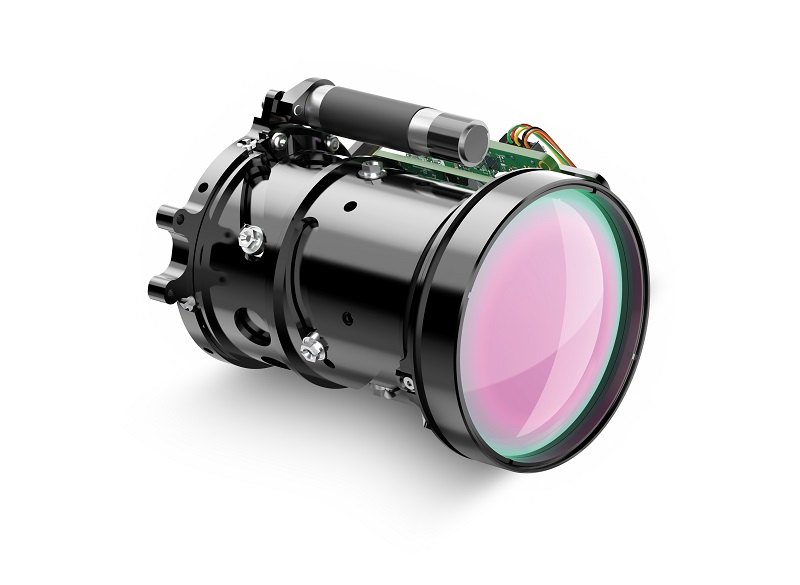
MKS Instruments, through its Ophir Optronics brand and subsidiary, unveiled a new addition to its LightIR family of low-SWaP, motorised continuous zoom IR lenses, the Ophir LightIR 18-225 mm MWIR f/4 product. It is optimised for use with 10 µm pixel SXGA/HD FPAs (focal plane arrays) and 15 µm VGA FPA detectors.
“The new zoom lens addresses the recent market shift toward smaller pixel size IR detectors,” said Dr Kobi Lasri at Ophir Optronics. “Its cost-versus-performance ratio is intended as an enabler for advanced tactical UAV and small gimbal thermal imaging applications.”
The lens’ optical elements have been designed to minimise its length and weight in order to reduce the length of any optical system integrating it. Its total weight is 326 g, it is 86 mm long and its diameter is 61.4 mm, with the housing providing IP67 protection to the front element. It can be operated in temperatures from -32 to +75 oC, and consumes up to 1 A peak current (or just below 0.5 A in standard operations) on a 12 V input, with data output over RS422.
If paired with a 10 µm detector at 1280 x 1024, its FoV ranges from 3.3 to 39.1 o. When using a 15 µm pixel pitch detector and configured for 640 x 512 imaging, the lens provides a maximum FoV of 29.9o and an FoV of 2.4o at maximum focal length.
The electric motor in the lens enables it to go from maximum to minimum zoom in just under 5 seconds, with a focus time of just below 2 seconds.
Autel Robotics showcased its newest UAV, the EVO Max 4T, which it has developed for applications including commercial operations such as mapping and industrial inspection, emergency services such as search & rescue, firefighting surveys and public safety monitoring with police.
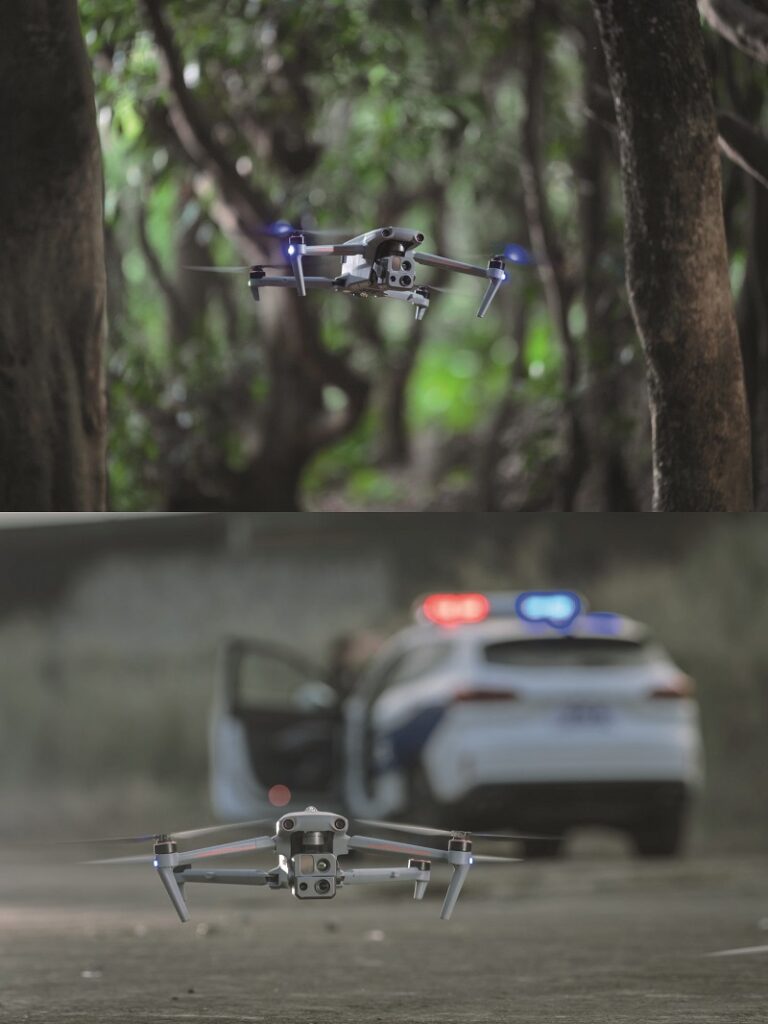
The UAV is a quadrotor with a 1999 g MTOW and maximum dimensions of 576 x 660 x 149 mm (including its propellers). It is powered by a 4S lithium-polymer battery that weighs 520 g, stores 8070 mAh or 120 Wh of energy, delivers power over a 14.88 nominal voltage, and provides up to 42 minutes of flight between charges or swaps of the pack.
Its standard payload is a gimbal with four sensors. Two of them are EO cameras, one of which is an 8K, 48 MP system with a 10x optical zoom and a half-inch CMOS sensor for inspecting targets up to 2 km away. The other is a 50 MP camera built around a 1/1.28 in CMOS sensor designed for wider-angle shots as well as 4K 30 fps video.
The other two sensors are a 640 x 512 IR camera that incorporates an uncooled VOx microbolometer as its detector, and a laser rangefinder with a 1.2 km range.
For fleet or swarm operations, the UAV integrates Autel’s A-Mesh 1.0 radio. This enables multiple EVO Max 4Ts to be overseen from a single GCS, and for other EVO Max 4Ts in the mesh to communicate with each other so that if one should suffer a fault or crash, the others can reposition themselves to maintain survey coverage.
Users can monitor and take control of the UAV via the Autel Smart Controller V3, a battery-powered tablet GCS with a 20,148 x 1536 resolution, 7.9 in display. Footage captured by the UAV can be downloaded at 20 Mbytes/second, and additional monitors can be connected via HDMI.
There are plans for a range of future updates to enhance the autonomy and planning capabilities that can be realised through the GCS. These include vertical survey patterns of towers and pit walls, corridor surveys of roads, pipelines and rivers, and automatic terrain-following, for topographic surveys as well as preventing collisions with the terrain.
Autel also demonstrated its Dragonfish Series of UAVs, all three of which are VTOL-transitioning aircraft with tiltrotors mounted at the tips of their fixed wings and vertically oriented rotors on top of their noses and tailplanes.
The series consists of the 5.5 kg Dragonfish Lite, the 9 kg Dragonfish Standard, and the 17 kg Dragonfish Pro, all of which have a top speed of 108 kph and are built with carbon composite airframes rated to IP43 protection and operating in temperatures from -20 to +50 oC.
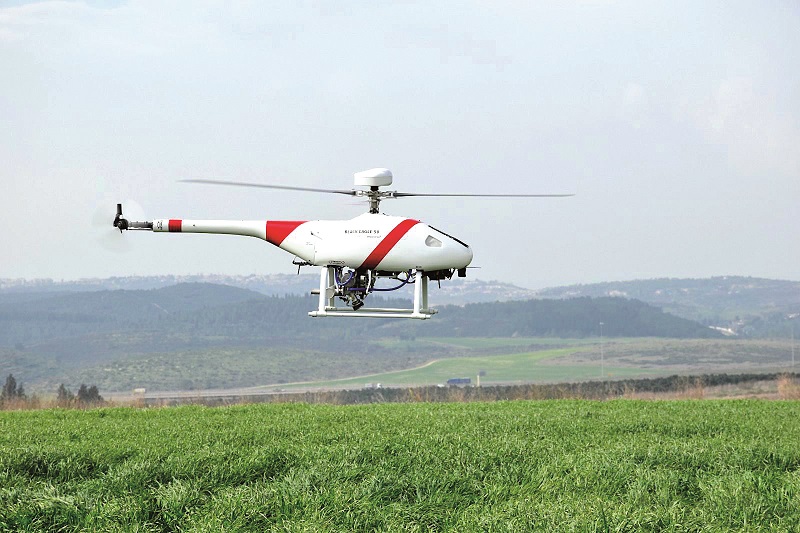
Steadicopter has updated its BlackEagle 50H helicopter UAV with a new payload integration capability, which is available on request and is aimed at users engaged in long-range maritime survey operations and border protection.
The Micro Maritime Patrol Radar (µMPR) from Bird Aerosystems has been designed to serve as a SWaP-optimised sensor for airborne tracking and identifying vessels over a wide radius. Its data can be fused with that from an aircraft’s AIS and EO/IR systems to achieve more precise and detailed identifications of targets including real-time georeferencing.
The µMPR can track up to 50 targets at once over a typical range of up to 30 km, or up to 40 km for larger targets with a radar cross-section of at least 1000 m². It weighs about 7 kg and consumes just under 200 W from a 28 V DC supply.
The Black Eagle 50H meanwhile is a 50 kg MTOW aircraft, hybrid powered for a maximum flight endurance of 5 hours, a top speed of 126 kph and a cruise of 83 kph. It is 3100 mm long, its main rotor having a diameter of 2800 mm, and it can fly at up to 16,500 ft (5029 m) in addition to withstanding wind speeds of up to 46 kph during VTOL.
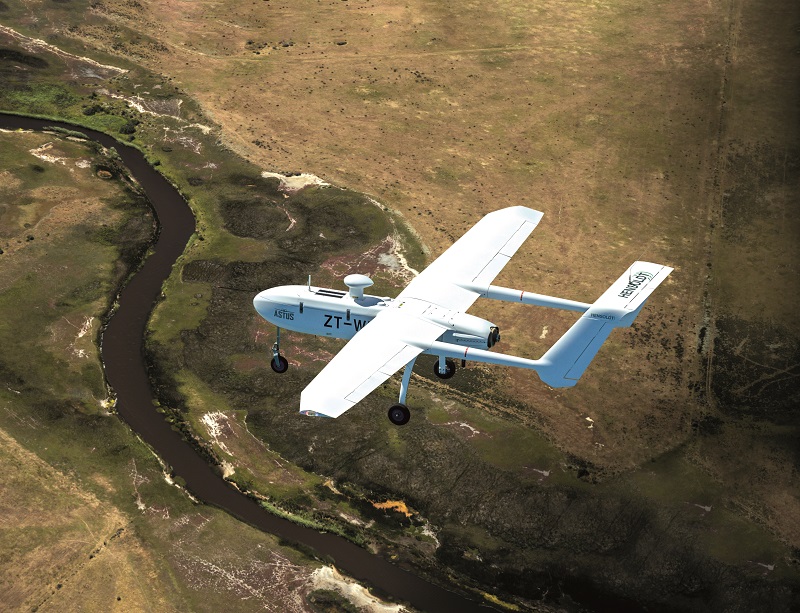
Robotican showcased the latest version of its Rooster, a hybrid uncrewed vehicle capable of aerial flight as well as ground travel.
The system features a quadrotor hub fixed inside a protective cage, with the cage being free to roll in the lateral or pitch axis. That means the cage functions essentially as a wheel, allowing the Rooster’s rotors to propel it through the air or along the ground.
The Rooster’s battery enables up to 12 minutes of flight or up to 45 minutes of ground travel, given
that the propellers are no longer fighting gravity as the UAV-UGV hybrid rolls along the floor. Up to 90 minutes of total mission duration is suggested by Robotican, as the vehicle can also turn off its motors for stationary observations.
The company has designed the system with different missions in mind. One is search & rescue, with its combined flight and crawling modes enabling it to traverse through collapsed caves and structures. Its ability to sit stationary, without needing a clear landing space (as many multi-rotors do) means it can watch and listen for signs of survivors.
Other applications include ISR for defence and security agencies, as well as indoor maintenance inspections of industrial facilities.
The Rooster weighs 1.45 kg and carries up to 300 g of payload, including a 1080p EO video and NIR thermal cameras. It also integrates multiple mesh radio options in order to maintain a clear and secure data link with its GCS in metal and concrete-rich environments.
Heven Drones attended the show to unveil the first aircraft in what is to become its H2D line of hydrogen-powered UAVs.
The H2D55 is an X-8 multi-rotor with a MTOW of 25 kg. It features four coaxial motor-propeller drive pairs, and is powered by a PEM fuel cell from an unnamed supplier. Heven Drones also tells us that it is working with US-based Plug Power on other parts of its hydrogen ecosystem as well as some of the larger fuel cells for larger systems it is creating.
The PEM cell and onboard hydrogen gas storage give the H2D55 a
120 minute maximum flight time, assuming a 5 kg payload and depending on weather conditions, or 100 minutes with a 7 kg payload.
The H2D55 is also able to fly at a maximum airspeed of 54 kph, tolerate wind speeds of up to 37 kph, and cover a nominal distance of 60 km per flight. It is offered as a multi-role solution for defence as well as commercial applications, the latter of which includes agricultural and enterprise surveys, and last-mile deliveries.
Future models in the H2D line,with greater flight times and payload capacities than those of the H2D55, will be announced in the future.
Hensoldt Group showcased its ASTUS UAS, which is designed principally as an airborne sensor platform for monitoring and protecting high-value assets such as critical infrastructure, as well as border patrol missions and long-distance ISR.
The ASTUS has been developed and flight tested over the past 3 years, during which Hensoldt’s engineers have verifyied key operational capabilities of the aircraft.
Willie Malan commented, “We have proven that the platform is very stable and can handle any operational challenges in all weather conditions day and night.”
These challenges included the integration of different EO payloads, their use in aerial tracking of illegal activities, vehicles and personnel, as well as laser target designation and relaying surveillance information to ground forces in real time.
These capabilities are enabledthrough a range of mission-critical avionics including ISR cameras, gimbals, radars, data links and transponders. A synthetic aperture radar for the UAV is also to be developed with a partner.
The ASTUS can fly for up to 8 hours and to a flight ceiling of 16,000 ft, with a 200 km data link for live telemetry. At the time of writing, it was entering initial series production, with further tests aimed at trialling some optional mission systems for military and civilian users.
UPCOMING EVENTS
























